I love good quality food, but I also have a small place in my heart reserved for convenience foods like instant ramen or frozen pizzas. I don’t indulge in them often, and when I do I often spruce them up with something special to make them a little more interesting. I’ve posted before about the things I like to add to my instant ramen to give it an upgrade, and now I have a new favorite ingredient—gochujang! This sweet-salty-spicy paste creates a rich broth with plenty of umami that I balanced with some fresh spinach and chunks of mild tofu. This Gochujang Ramen with Tofu is a quick and easy way to indulge that noodle craving!
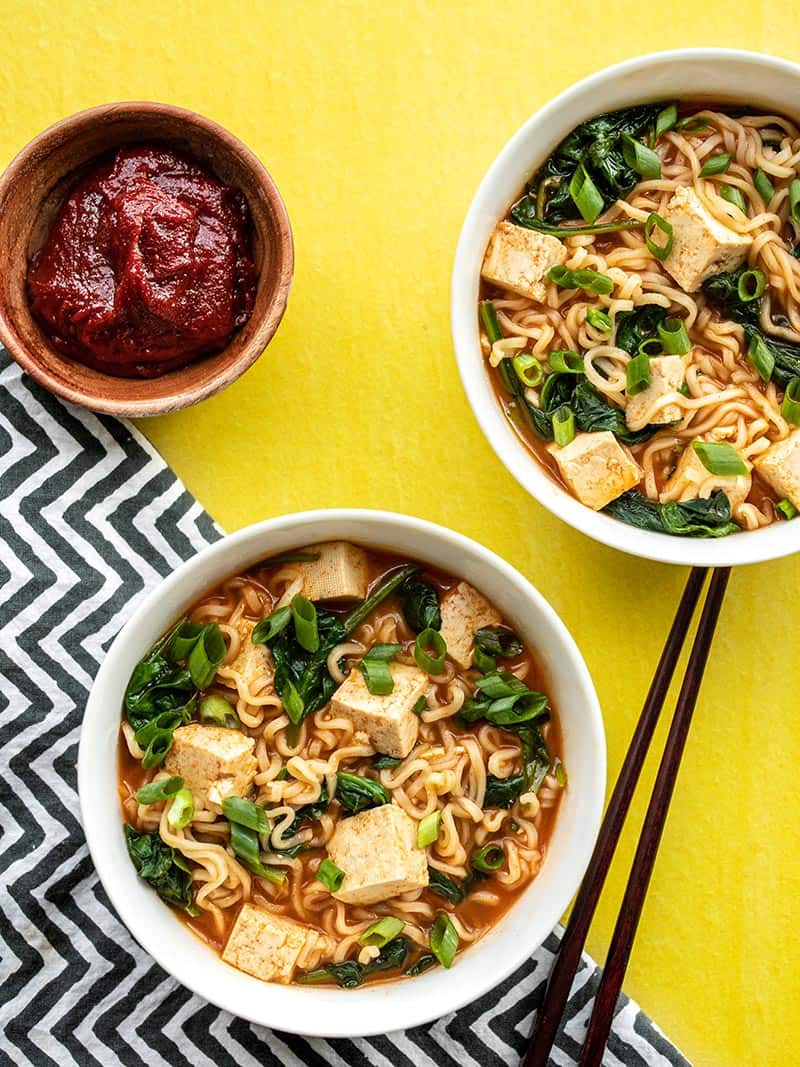
What is Gochujang?
If you’ve never heard of gochujang, it’s a Korean chile paste made with chile peppers, rice, fermented soybeans, and salt. It kind of reminds me of a spicy version of miso. Gochujang is really starting to trend in the U.S. because of its uniquely sweet-salty-spicy and UMAMI flavor. And because we’re all kind of over our infatuation with sriracha and looking for the next best thing. It’s those fermented soy beans that really set gochujang apart and give whatever you’re adding it to that extra “WOW” factor. So if you haven’t tried it yet, put it on your list!
Where to Buy Gochujang
Because gochujang is really becoming quite popular, you’ll probably be able to find some at most major grocery stores. My local kroger actually carries about 4-5 different kinds! I’m using this Sempio Gochujang. If you have an Asian grocery store near you, you’re sure to find a really good selection there, and probably much better prices. Want to try to make your own? Try this traditional gochujang recipe, or this quickie 5-minute gochujang.
To Use the Ramen Packet or Not to Use the Ramen Packet
Personally, I like to use my own broth when making ramen instead of using the little seasoning packet that comes with the noodles. I like the freedom of tweaking the flavors and salt content, but you can use the seasoning packet if you prefer. Gochujang has quite a bit of salt, so if you do want to use the flavor packet that comes with the instant ramen I suggest adding the gochujang to the water first (3 cups water), then adding a little of the flavor packet at a time until the broth reaches a reasonable salt level for you.
How Spicy is It?
Decently spicy, IMHO. You can reduce the amount of gochujang to make it slightly less spicy, if you prefer. Or, if you’re looking for non-spicy ways to spruce up your ramen, check out my post about 6 Ways to Upgrade Ramen, or my Vegan Creamy Mushroom Ramen.
What Should I Do With my Leftover Tofu?
This recipe uses half of a traditional 14oz. block of tofu. My first choice for using up the other half of the block would be to make a half batch of my Curried Tofu Salad. That stuff is to die for. You could also toss it into a stir fry, or chop it up, add some BBQ sauce and make yourself a BBQ Tofu Slider.
Try These Other Instant Ramen Recipes
Gochujang Ramen with Tofu
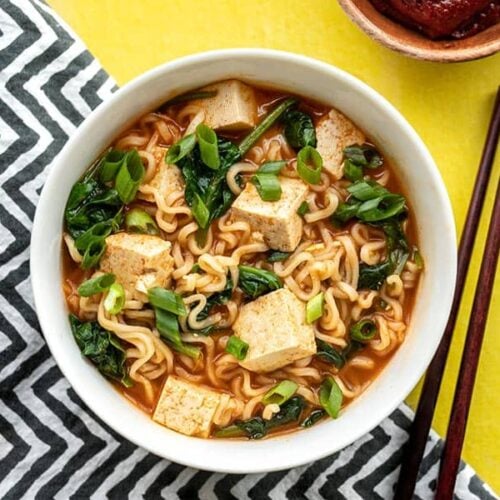
Ingredients
- 7 oz. extra firm tofu ($0.90)
- 1 cup water ($0.00)
- 2 cups vegetable broth* ($0.26)
- 2 Tbsp gochujang ($0.46)
- 1 package instant ramen* ($0.19)
- 2 cups fresh spinach ($0.25)
- 2 green onions ($0.20)
Instructions
- Drain the tofu and cut it into 1/2-inch cubes.
- Add the water, vegetable broth, and gochujang to a small sauce pot. Whisk until the gochujang is dissolved.
- Add the cubed tofu to the pot, place a lid on top, and bring it up to a boil over high heat.
- Once boiling, add the instant ramen noodles (without seasoning). Boil for one to two minutes, or just until the noodles begin to soften and pull loose from each other.
- Add two handfuls (about 2 cups) fresh spinach and stir it into the hot broth until wilted. The noodles will finish cooking as the spinach wilts.
- Slice the green onions and sprinkle over top of the ramen just before serving.
See how we calculate recipe costs here.
Notes
Nutrition
How to Make Gochujang Ramen with Tofu – Step by Step Photos
Drain a 14oz. block of tofu and cut half of it into ½-inch cubes. See the notes above the recipe for ideas for using the remaining tofu.
Add 1 cup water, 2 cups vegetable broth, and 2 Tbsp gochujang to a small sauce pot. Whisk until the gochujang has dissolved.
Add the cubed tofu to the pot. Adding the tofu before we start boiling the broth gives it a few minutes to start absorbing some of the flavor from the broth, as opposed to adding it at the end. Place a lid on the pot and bring the broth up to a boil over high heat.
Once boiling, add the block of instant ramen noodles (without seasoning packet). Let the noodles boil for about a minute, or just until they being to soften up and loosen up from the block.
Add a couple handfuls of spinach to the pot and stir it in until wilted. This should give the noodles just enough time to finish cooking as well.
Slice two green onions and sprinkle them over the ramen just before serving.
Enjoy that spicy goodness!! The egg fanatic in me is dying to add a soft boiled egg in there, too!


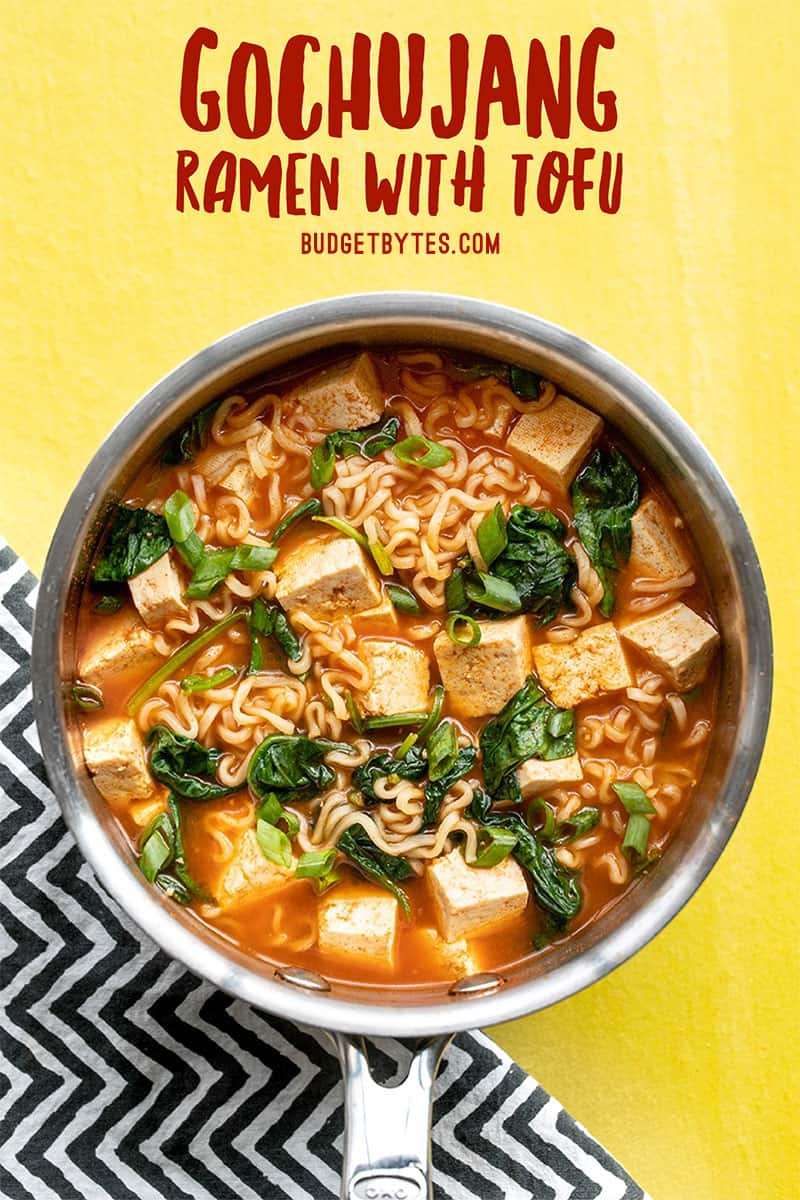
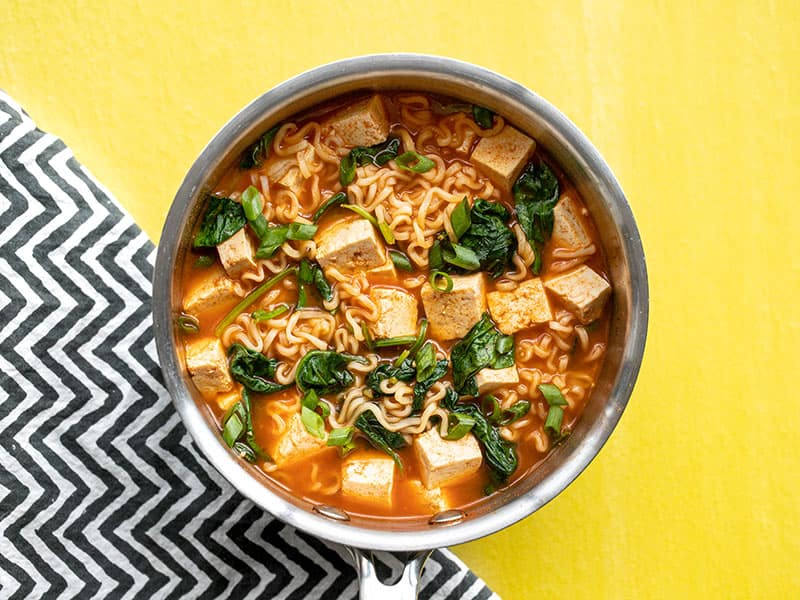
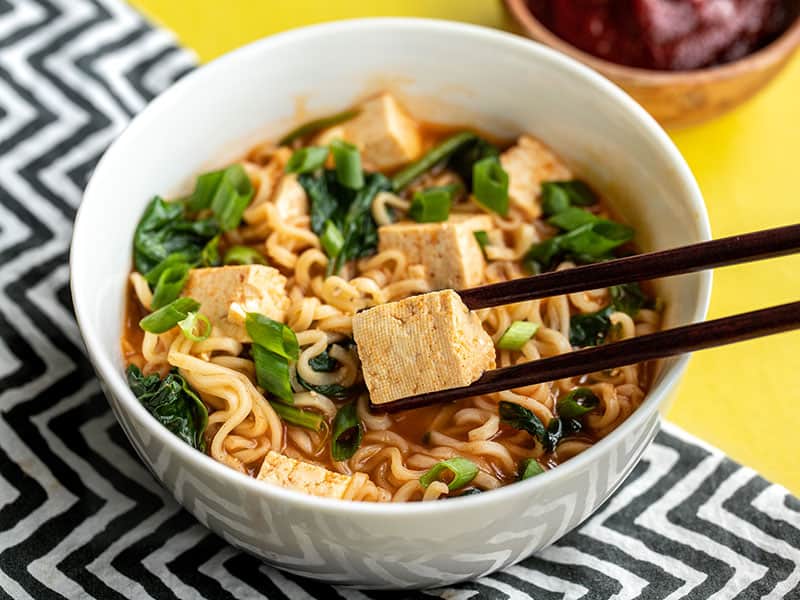
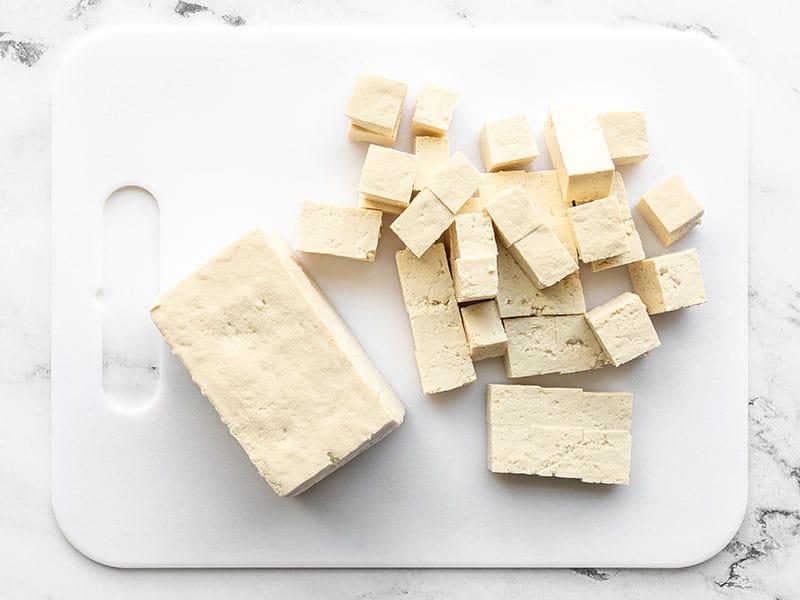
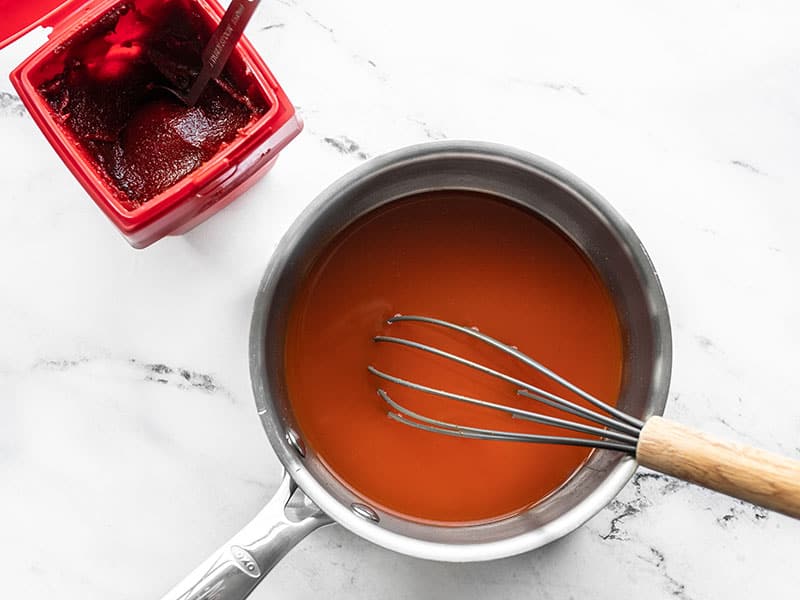
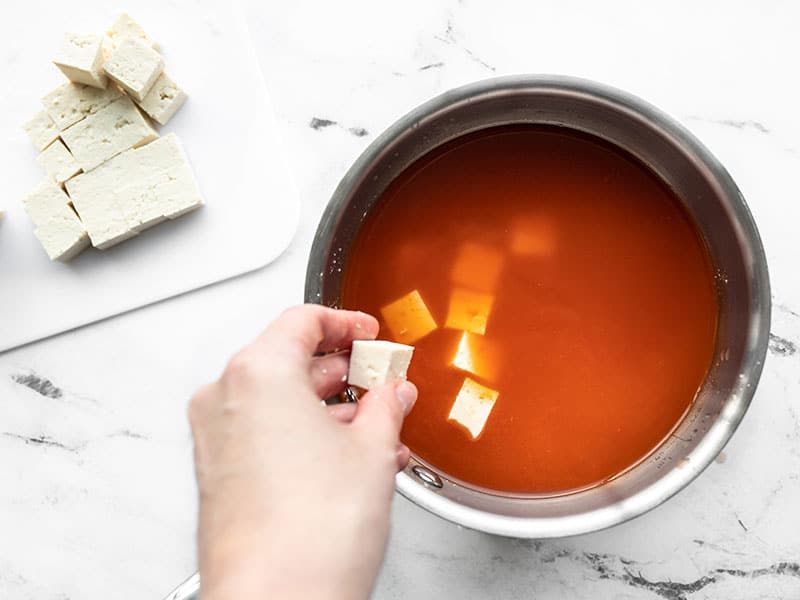
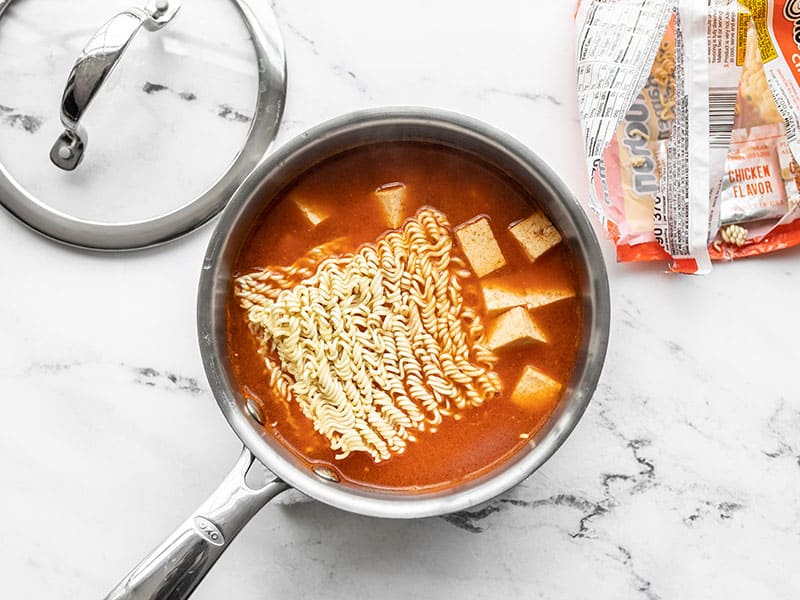
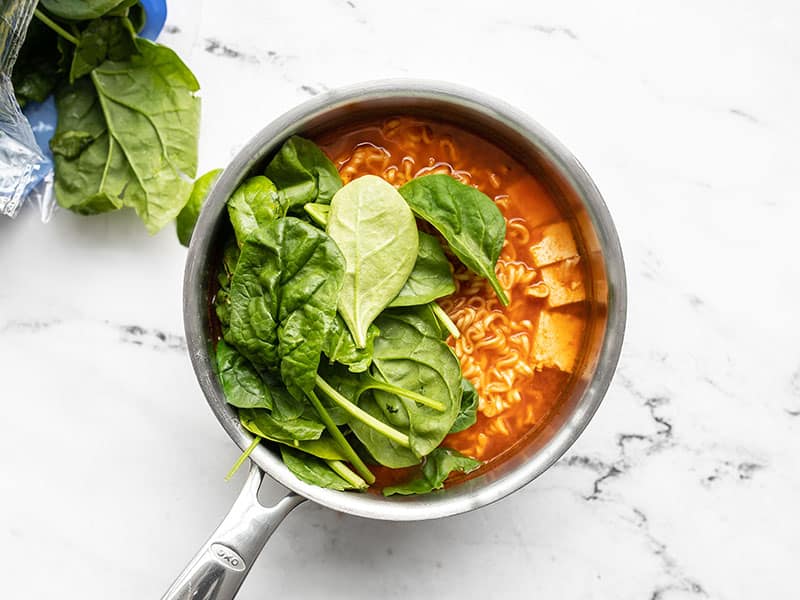
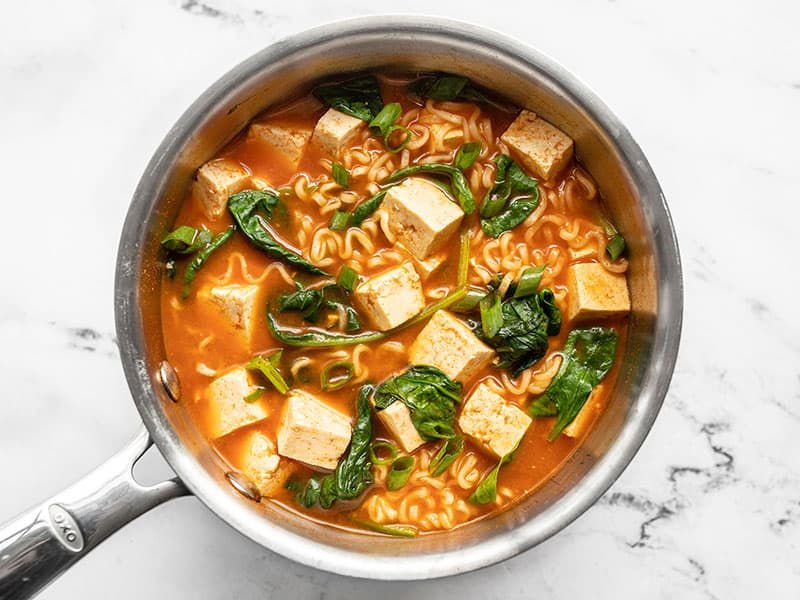
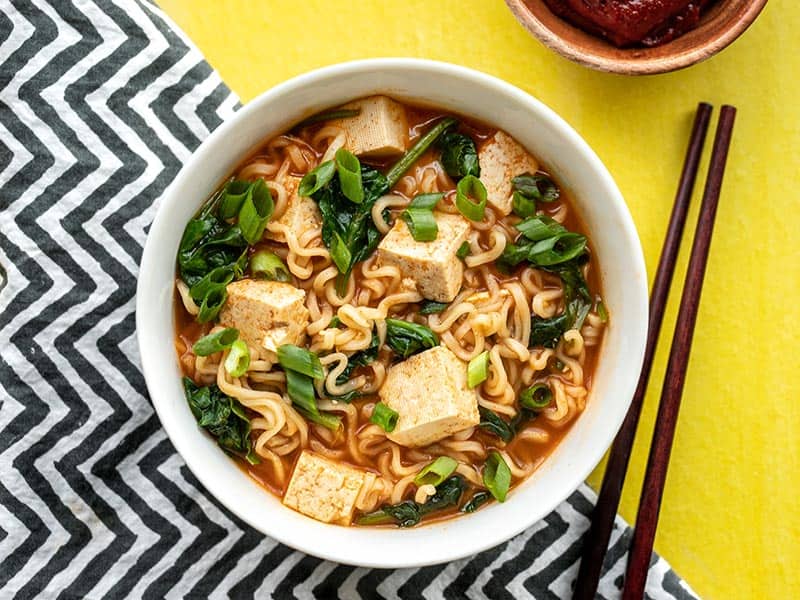
We liked this recipe, but here are the changes we are planning to make next time:
half as much gochujang – it’s tasty but very, very spicy!
Add the ramen flavor packet to the broth as well, for more depth of flavor
Add a poached egg for a more creamy broth and to make it more filling
Add bean sprouts for additional vegetables and some crunch
Hello. I guessing we should use “firm” Tofu. Right? Thank you. John
Hi John, the ingredient list says to use extra firm, but if you already have firm on-hand that should work okay!
I made this recipe for dinner tonight. It was delicious! Instead of gochujang, I used white miso (it was what I had on hand) and it turned out great! I will be making this again.
I made this for lunch today. This time I used gochujang and it turned out great. So delicious! 😋
Loved this! I made it for meatless Monday and then proceeded to add some XO sauce to my bowl :p It was lovely on its own, but the umami turbo boost from the XO was perfect. This one is going into our rotation :)
Sooo delicious and fast and spicy. Thank you!
Made this tonight! This will be one of my winter go to meals! So good!
Here’s a tip on the firm tofu. Freeze it first. Frozen tofu is a staple in Chinese hot pot. It expands the pores in the tofu, which basically makes it a flavor sponge, and it is one of my favorite things (I press out the excess liquid before using it)
Always looking for ways to fancy up my instant ramen. :)
Do you drain the tofu before freezing?
My two cents is freeze with the liquid, but press and drain really well after thawing. :)
I’m not a big ramen soup person normally, so I didn’t know what to expect making this. I was pleasantly surprised with how delicious it was for being so simple. I followed the recipe exactly with 2 tbsp gojuchang, which wasn’t as spicy as expected. Super filling for two people, and cheap.
FYI– this is missing from the tofu index page. :)
Thanks! Fixing now. :)
So good and so easy! I make this all the time. My hubby and I love it.
IMO you should actually use korean style extra soft tofu that comes in a tube and add it later :)
This wasn’t good at all.
This was great inspiration for my ramen today !! I added some beaten egg and kewpie mayo to the broth to make it creamy, and added mushrooms. Served with seaweed and Lao Gan Ma on top!!!
I like my ramen soupier so I’m using 4-6 c. chicken stock. I’m also using dried ramen noodles so they’ll cook a few minutes longer, meaning that they go in the soup a few minutes before the tofu. Going in with the noodles is the white part of a baby bok choy, sliced crosswise. Using the green leaves instead of spinach, so they’ll wilt last, a few minutes after adding tofu. I’m also adding soy sauce and Sichuan chili oil, maybe some sliced dried chilies if it’s not hot enough for me. Mixing in some toasted sesame oil. Final topper will be Sichuan green peppercorn oil.
Can I add chojang instead of gochujang in ramen?
I haven’t tried that in this recipe, but it’s worth a shot! Let us know how it is if you do try it. :)
Loved it! Added korean soybean paste and mayo (sounds odd but it’s really good, add a creaminess to the broth) and it was really good!
Just made this and the flavor of the broth was great! The tofu pieces were a little bland at first, so I’m thinking I may need to let it sit in the broth longer to soak up the flavor. By the end of the meal, I really enjoyed it all!
This is an extremely simple, easy, and delicious recipe!!! I’ve made this 3 times now. I always double the recipe and make it exactly as Beth has it. Thank you, Beth!
Another option for the leftover tofu? Make a double batch of this recipe! (At least that’s what I did…) I still only used 2 tablespoons of gochujang though and added in a little MSG to boost the flavor. Also highly recommend adding a soft-boiled egg if you’re not vegan. Another quick, easy, and delicious instant ramen recipe, thanks Beth!
When you “drain” your tofu, are you pressing it out on a towel, or just cutting it up and letting it sit in a strainer? (how long?) I haven’t worked with tofu in quite a while, and the last time I did, it just crumbles no matter how much I press it out, and no matter how firm it was to begin with. Would love your insights… Thanks!
For this recipe I didn’t press the tofu at all. The tofu I used comes in a plastic container with a bunch of liquid, so I just drained the block from the liquid that is in the package. You do definitely need to be gentle with it when it’s in the pot because it can break apart if you handle it too much. I also find that some brands are more delicate than others, so you may just need to find one that works well for you. :)
My new favorite way to do ramen. The gochuchang/veggie broth combo was new to me. I loved that umami flavor.
My adjustments: one of them was to cut the gochuchang in half, since I’m trying to avoid having a runny nose in my Zoom meetings. I also swapped out the tofu for portobello mushroom slices and added a boiled egg (per how Beth taught us in other recipes) and dash of low-sodium soy sauce to finish. A fast, filling lunch!
This was really good as a hot soup but also really good as a chilled soup. I took the leftovers out of the refrigerator and decided not to heat it up. I used a peas and carrots mix instead of the spinach. It was light and refreshing.
This was super tasty. I added a soft boiled egg for some extra protein., and used sriracha in place of gochujang (which doesn’t seem to have made it to my local – Australian – grocery store yet).
I just made this for the 1st time-very easy and very yummy! I used Korean sweet potato glass noodles instead of ramen to avoid gluten. I also used Better Than Bouillon vegetable base for the broth. It’s excellent! First time I’ve ever had Gochujang and it’s amazing, love the heat and saltiness. I also added a large sliced red radish for crunch. Found all ingredients at my local Kroger (Fry’s). Thanks so much Beth! I’ve been following your recipes for 2 years now and have not been disappointed with anything I’ve tried. On to my 2nd bowl……
I save the little packets and add to the pot when I next make broth from scratch.
Personally I’d never use that seasoning packet unless there were no alternatives. It’s basically pure salt. Ugh. Which means the whole point of the Ramen package is the noodles, and I’m wondering if you can get “instant style” ramen in larger quantity?
I don’t know about larger quantity, but stores in Korea do sell ramen packages without the flavor packets. Maybe some Asian grocery stores in the US carry those too-?
Yes, you absolutely purchase packs of dry ramen, but you’ll probably have to go to an East Asian/Southeast Asian market to probably find them. Off the top of my head, Hakubaku (an Australian company) make dried noodles that are available in Western Markets like Whole Foods.
Here’s the website: https://hakubaku.com.au/
so you can see what’s available. Hakubaku’s noodles do not have salt or at least very minimal amount of salt. But if you’re in the hankering for fresh noodles, it’s really easy to make ramen noodles from scratch. :) Hope this helps!
You can find them on amazon! I had to buy gluten free and there were thousands of options. I’m sure there would be even more regular type ramen noodles
My local Walmart had Ocean’s Halo ramen. It was a box with four dried packets of ramen for about $3. No seasoning packets but they sell their broth individually in quarts.
I find it in bulk at Costco. It comes in a large bag with 6-8 blocks of noodles. I can’t remember how many right now. Probably not as good as an Asian market though :)
I like this, although I only added 1 T of the gochjang as I didn’t want it to be too spicy for me. I probably could have used 1.5 as it was a little bland. I now am wondering what do I do with all the rest of the gochjang. I’m also wondering about other minor tweaks – like different veggies, adding ginger or garlic. I’d love some guidance and ideas.
Use it to make bibimbap or dalk galbi!
You can use gochugang to make tteokbokki, Ive been wanting to tteokbokki for a while but was worried I’d have leftover gochugang that I don’t know what to do with. So this ramen recipe is perfect timing.
Gochujang is used in a ton of Korean recipes, great in soups like this, or also great mixed into a meat marinade. Searching gochujang chicken, pork, or beef should give you lots of great ideas!
I already have a “spicy Korean style stir fry sauce” which I think has gochujang in it from the ingredients. I couldn’t find gochujang itself today. Think it will work? Definitely has some salt in it so figure I better be careful there.
I had a hard time finding gochujang. I called 4 supermarkets in my area. I found that Wegmans had it! Also, check your local Asian foods market.